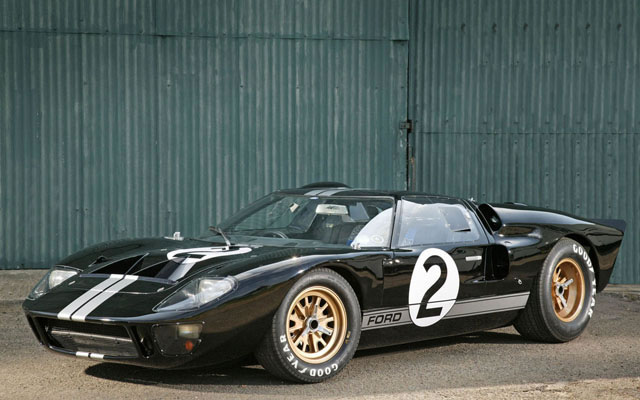Ford GT40 Mk.II

Trumpeter, 1/12 scale
S
u m m a r y
|
| Catalogue Number and Description: |
Trumpeter Item No. 05403 - Ford GT40 Mk II |
| Scale: |
1/12 |
| Contents and Media: |
See details below |
| Price: |
USD$233.96 available online from Squadron.com |
| Review Type: |
FirstLook |
| Advantages: |
Good quality moulding; high level of detail; includes beautiful photo-ecthed grills; opening hoods and doors |
| Disadvantages: |
|
| Recommendation: |
Visually, Trumpeter's big GT40 appears to be solid and should build into an impressive display model. |
Reviewed by Frank McCurdy

Trumpeter's 1/12 scale Ford GT40 Mk.II is available online from
Squadron
The GT represented ‘Gran Turismo’ while the designation 40 represented its height of only 40 inches. The number 40 was added to the designation when the Mark II was introduced.
The history of the Ford GT40 began in 1964 as an attempt by the Ford Motor Company to beat the Italian auto manufacturer at the grueling 24 Hours of LeMans endurance race, located near the small French town of the same name. Ford had attempted to buy Ferrari for $18 million a year earlier in order to run its international racing program. The purpose was to use the Ferrari Company and technology to help Ford achieve a LeMans victory. Due to the failure of those negotiations Ford decided to build their own super-car and beat Ferrari at its own game.

It took two years of development and disappointing finishes at LeMans in ’64 and ’65 before the GT40 Mk.II was completed with the help and expertise of legendary sports car designer Carroll Shelby and NASCAR performance specialists Holman-Moody. More than a hundred cars were produced with no fewer than eight Mk.IIs being meticulously prepared for the 1966 24 Hours of LeMans. Although the cars were entered by three different privateer teams on paper, Ford Motor Company headed the operation and supplied most of the personnel in the pit boxes. Ford’s assault was further backed by five older GT40 Mk.Is. By contrast, the big nemesis, Ferrari fielded only three of their latest generation prototypes.
The 24-hour race proved to be particularly grueling and only 15 of the 55 starters reached the finish line. All of the Ferraris had retired with seven hours to go, as had nine of the Fords, but the survivors held together long enough to score a historic 1-2-3 finish. Ford had finally broken Ferrari's hold on road racing, and stopped their six win streak. Henry Ford II's hope of winning Le Mans had come true. The winning car was again driven by the team of McLaren and Amon, who also set a record for the fastest race average speed at 125.4MPH. The second place car was driven by Ken Miles and Lloyd Ruby. And finally, the third placed team was Ronnie Buckman and Dick Hutcherson.
Ford would repeat this feat three more times until the FIA changed the rules to remove them from the competition.
I have been patiently waiting for this kit 43 years, since that day in 1966 when thee real car set new records at LeMans. A car as famous as the Ford GT40 deserved to be produced in a mainline plastic kit in this scale long before now. I was very happy when I saw it had finally arrived.
The GT40 Mk.II comes in a large sturdy box full of parts. The packaging is quite impressive in that Trumpeter went to great lengths to ensure safety of the sprues until removed by the builder. The body shell is in its own protective box within the larger box as are the vinyl tires to protect the surrounding plastic.
The 32-page instruction booklet is very detailed. The decals look in-register.
The prototype car is predominately black but the majority of the sprues are white styrene. This is actually a plus as black styrene tends to be somewhat brittle. There are several sprues of chrome plated parts along with lots of clear pieces. The wheels are molded in a copper color. An odd feature is that one of the major structural pieces is partially pre-painted silver to represent aluminum used on the 1:1 meaning it will have to either be masked or repainted. The car’s grills are well provided for by several beautiful photo-etched screens. Lots of vinyl tubing is supplied to represent various bits of wiring. Even corrugated tubing is provided for the brake cooling tubes.
Initial inspection of the parts indicates that engineers did their homework and put out a quality product. I have not dry fitted any of the parts because with the many small pieces I don’t want to chance loosing them before assembly is started. The finished kit will have opening hoods and doors. Visually, it appears to be solid and should build into an impressive display model.
Trumpeter apparently never visited the actual car which is displayed at the Indianapolis Motor Speedway Museum. The car retired after its LeMans win and with the exception of a wash it is displayed as it was when it won. Included is a photo of the replica Mk.II that was used by Trumpeter as a go-by.
Lastly, the cost is something that can only be appreciated by a die-hard GT40 fan, of which I am one. The kit retails for US$259.00. When compared to 1/12th scale kits by Tamiya, the cost is comparable. It can be found for less and most mail order houses provide free shipping on orders costing this much.
Now my patient wait begins again for its newer brother, the 1967 Ford GT40 Mk.IV. What about it Trumpeter?
Text and Images Copyright © 2009 by Frank McCurdy
Page Created 23 July, 2009
Last updated 29 February, 2008
Back to HyperScale Main Page

|
